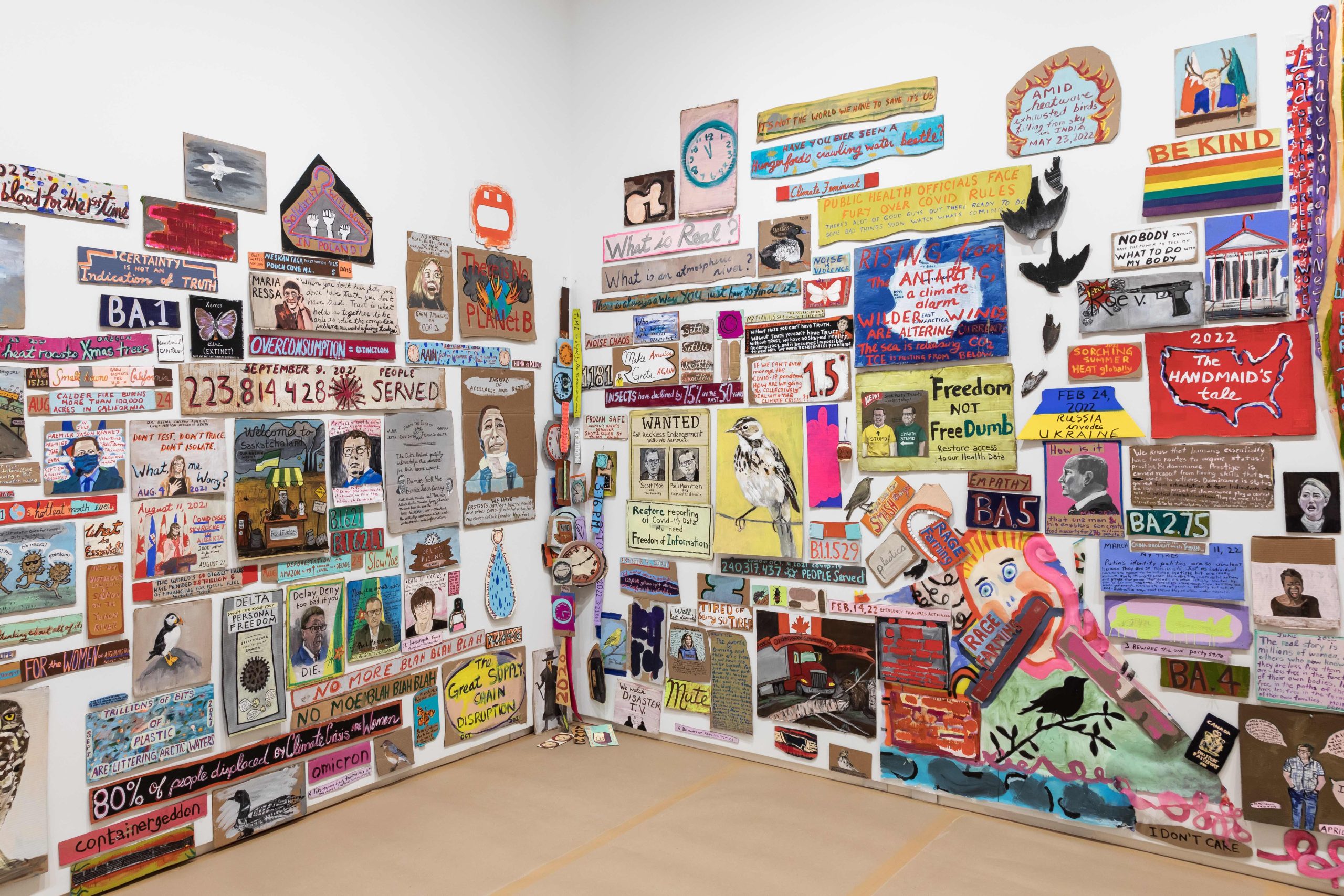Journal of the Plague Year(s) Diary: “A report from our bubble”
Written by Dawna Rose and Betsy Rosenwald
Saskatoon-based artists Dawna Rose and Betsy Rosenwald are in residence at Remai Modern until January 29, 2023 to work on their ongoing collaborative project Journal of the Plague Year(s). During their time at the museum, they will share their thoughts on the project, the time we’re living in, and where the work is going next.
Diary entry 1 – December 6, 2022
2020 was a year none of us will ever forget. We will remember where we were and who we were with. Did we work from home, bake bread, wear pants, wash our groceries, microwave our mail? Did we get sick or know someone who did and stand by helplessly because we couldn’t visit them in the hospital? We watched the news, read the news, listened to the news, tuned in to briefings from the Prime Minister (81 during the first 110 days), the premier, health ministers, chief medical officers, the WHO, the CDC, and checked the data daily to find out if we’d flattened the curve. We wore masks. We didn’t wear masks. We prayed for a vaccine and protested against it. We banged on pots for healthcare workers who worked against impossible odds to save us, then refused to listen to them. We watched America go mad. 2020 was a year that one letter to the editor or one postcard to our MLA would never be enough. Letters turned into protest signs, and in our case… lots of signs. Journal of the Plague Year(s) is a report from our bubble.

Diary entry 2 – December 12, 2022
An American eagle shouting Enough is my one of my earliest paintings in Journal of the Plague Year(s), made before I thought the pandemic would last a year, never mind year(s). It’s kind of a hybrid—a link between a bird project Dawna and I were working on and what would become our collective journal. I painted it on Black Tuesday—June 2, 2020–a week after George Floyd was killed by police in Minneapolis, igniting massive protests against racism across the U.S. and beyond. It was as if all the rage bottled up from the constant barrage of Trump tweets, the rise in racism, and the shock of the pandemic spilled out onto the streets. As if everyone was shouting, Enough, all at once.
—Betsy Rosenwald

Diary entry 3 – December 22, 2022
One question we consistently get asked about the show is, “What’s with the birds? How do they fit with a show about the pandemic?” In 2019, when all we knew about global pandemics was from the plot of a sci-fi movie, Science magazine published a research article stating that 2.9 billion birds have disappeared from North America since the 1970s. Yes, that’s almost 1 in 4 birds that have gone missing in the last 40 years. Some of the reasons for this include climate crisis, habitat loss, cats, building strikes, and widespread use of pesticides and other environmental contaminants. The species affected are not just rare and exotic birds, but the birds we see every day in our backyards. Saskatoon’s Northeast Swale is home to over 100 species of birds, including the threatened Northern Shrike. Shortly after the article appeared, we began painting birds on post-consumer cardboard to spread awareness of their disappearance and to generate support for a solution. We included them in Journal of the Plague Year(s) because they are beautiful, we love them, and they help to break up the relentless gloom of the pandemic. We welcome you to join us by making paintings, drawings, photos, sculptures—in short, anything bird-related, and sharing them here: 2.9 Billion Birds Gone | Facebook

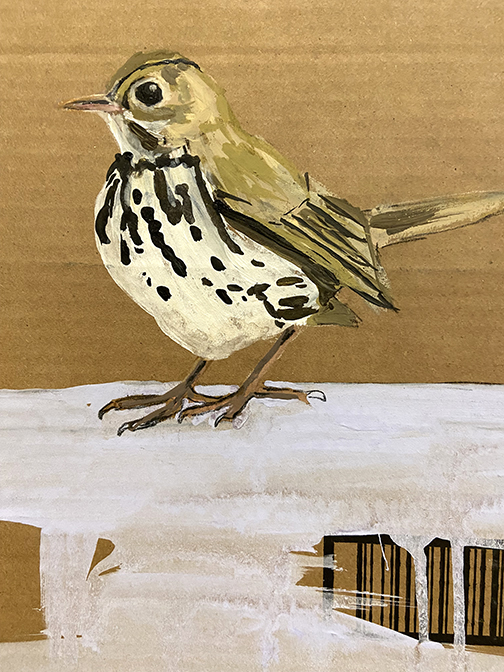

Diary entry 4 – January 16, 2023
Journal of the Plague Year(s) shines a light on those who told the truth about the events of January 6th, despite the possible negative impact on their lives. This month marks the second anniversary of the January 6th insurrection in Washington, DC. The violence of the day as well as the months of disinformation leading up to it created a template that is now being used by authoritarian regimes around the world, most recently in Brazil by Bolsanaro. By spreading doubt and promoting disinformation, they intend to prevent the peaceful transfer of power, a hallmark of democracies worldwide.

As Maria Ressa, 2021 Nobel Peace Prize recipient, said: “Without facts, you can’t have truth. Without truth, you can’t have trust. Without trust, we have no shared reality, no democracy, and it becomes impossible to deal with our world’s existential problems: climate, coronavirus, the battle for truth.”

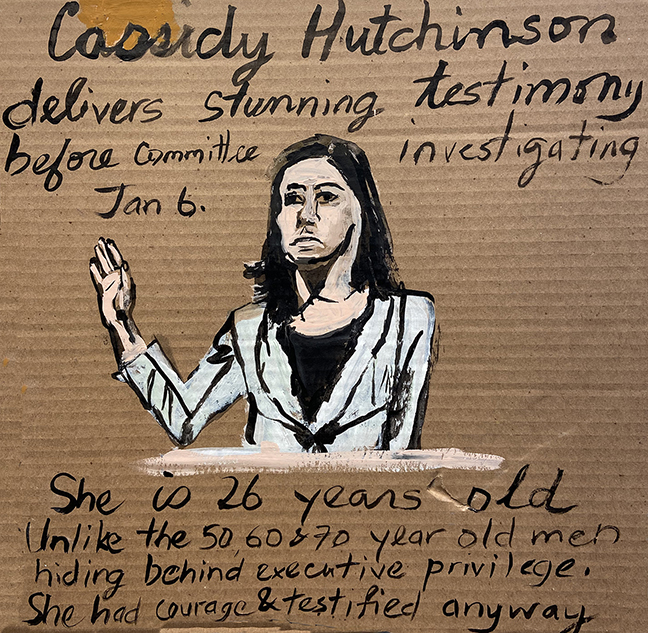

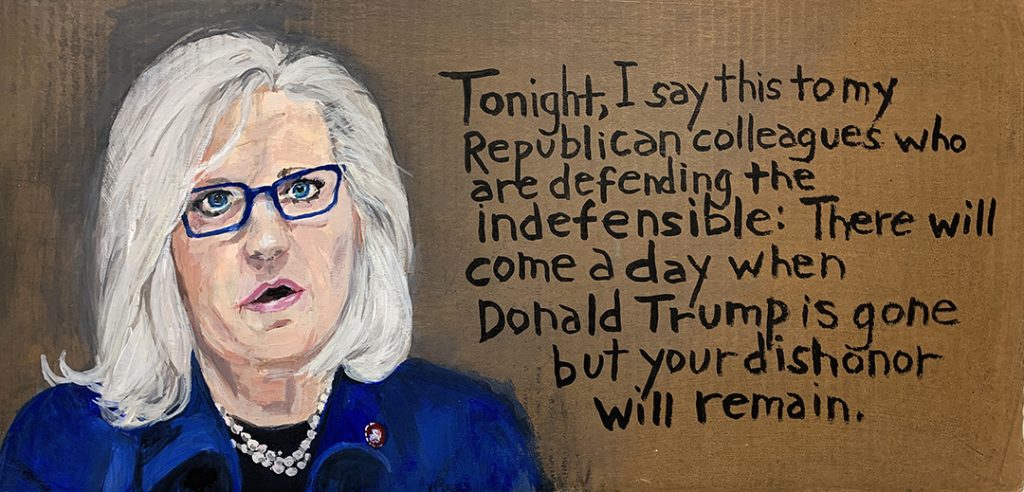
Diary entry 5 – February 24, 2023
Why the white rectangles on the floor?
The white rectangles painted on the cardboard-covered floor represent the blank A4-sized sheets of paper that became a symbol of the protests that erupted across China against zero-COVID policies in late November of 2022. Known as the White Paper protests or the A4 revolution, the demonstrations started in earnest after a building fire broke out on November 24, killing 10 people in the city of Urumqi where people had been locked in their homes for four months. The blank paper also represents the ruling party’s overwhelming censorship.
On December 7, 2022, the Chinese government lifted its most stringent rules and policies, which led epidemiologists to estimate that between 1 million and 1.5 million people have died in the past two months. This estimate is based on information that 90 million elderly Chinese remain inadequately protected from the virus. Many have not received a single vaccination, or received Chinese vaccines based on early variants that are less effective against new strains. The Chinese government focused on lockdowns and ended vaccination efforts in early 2022. Although the A4 protests might have caused the government to back down, China’s weakening economy and worsening supply chain issues may also have influenced the ruling party’s decision.
—Dawna Rose

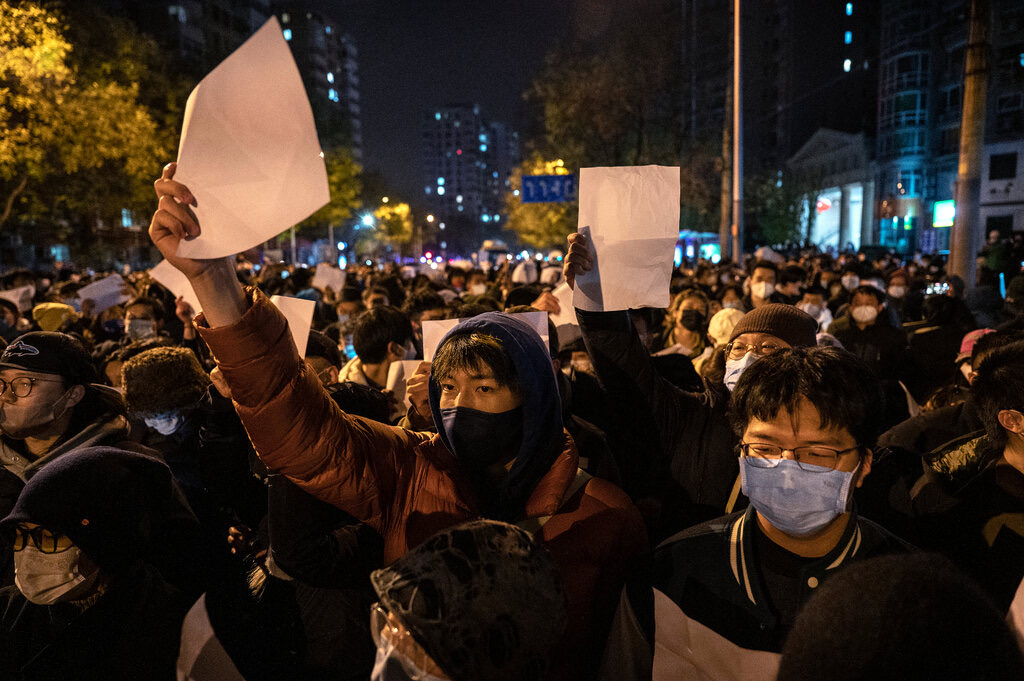
Diary entry 6 – March 1, 2023
Working without a net
Everything has been said already but since nobody was listening, we have to tell it again.
–Andre Gide
From November 21, 2022 to February 9, 2023, we had the unique opportunity to turn Remai Modern’s Connect Gallery into our studio. As we climbed the scaffolding to paint our 40 x 12 ft wall piece on cardboard, visitors to the gallery stopped to ask us questions, comment on our progress, and in the case of a few brave children, add some brushwork of their own. One of the most frequently asked questions was: Did you start with a plan?

Most mural painters begin with drawings that they digitally scale to a larger working size. We began with a spark of an idea: a painting about climate crisis and the extreme socio-economic disparities it has laid bare around the world, especially in the Global South. Due to record-breaking rains attributed to climate change, over a third of Pakistan was submerged underwater by the end of August, with thousands losing their homes, livelihoods, health, and lives. Ninety per cent of South Sudan has experienced devastating floods followed by drought, resulting in widespread famine and displacement. But rather than depict the wreckage happening in so many places around the world, we wanted to bring climate crisis home to Saskatchewan, because whatever is happening out there is also happening here. So we began by broadly painting a Saskatoon landscape: canola fields, the South Saskatchewan River, and the mud flats of Poplar Bluffs.
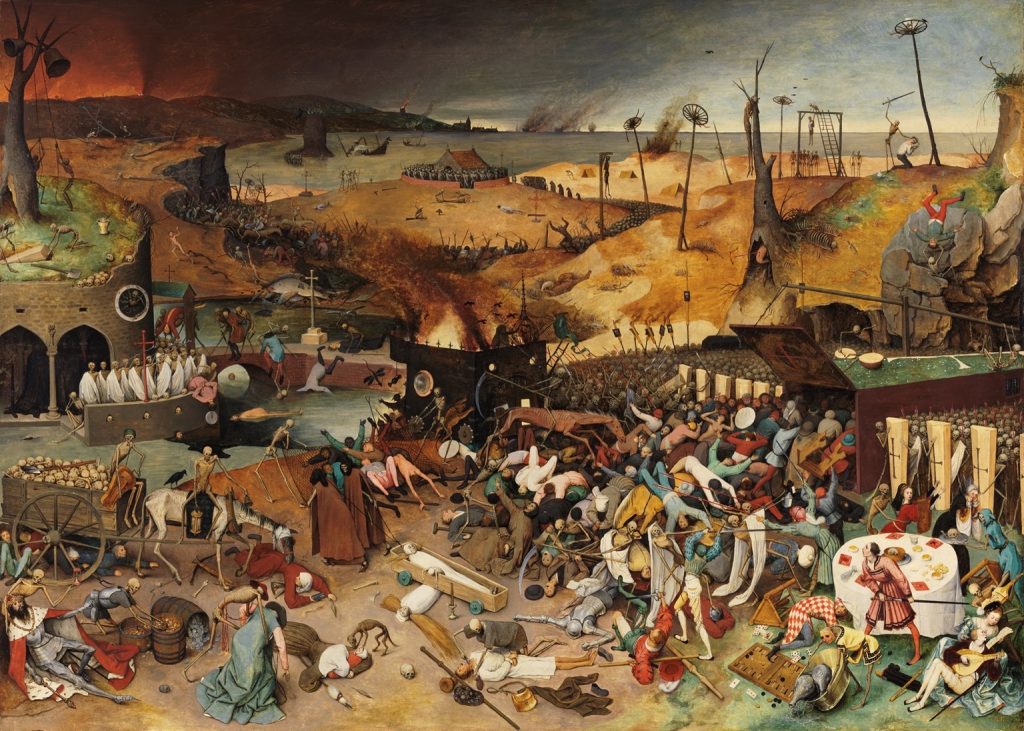
We were also thinking about how artists in history have depicted times of apocalyptic change. Working as religious upheaval and bouts of Black Plague destabilized Europe, Hieronymous Bosch (c 1450–1516) and Pieter Breughel the Elder (c 1525–1569) created visual incarnations of Daniel Defoe’s Journal of the Plague Year. We found freedom and inspiration in their fantastical allegorical scenes packed with outsized animals, birds, boats, fire, skeletons, and humans engaging in all manner of behaviours. In particular, we looked to Breughel’s Triumph of Death as an interpretive framework. A close look will reveal bits inspired by Breughel scattered throughout our work: notably, the bell ringing duo (far left), the figure crawling into the tree and the medieval Catherine wheels (far right).
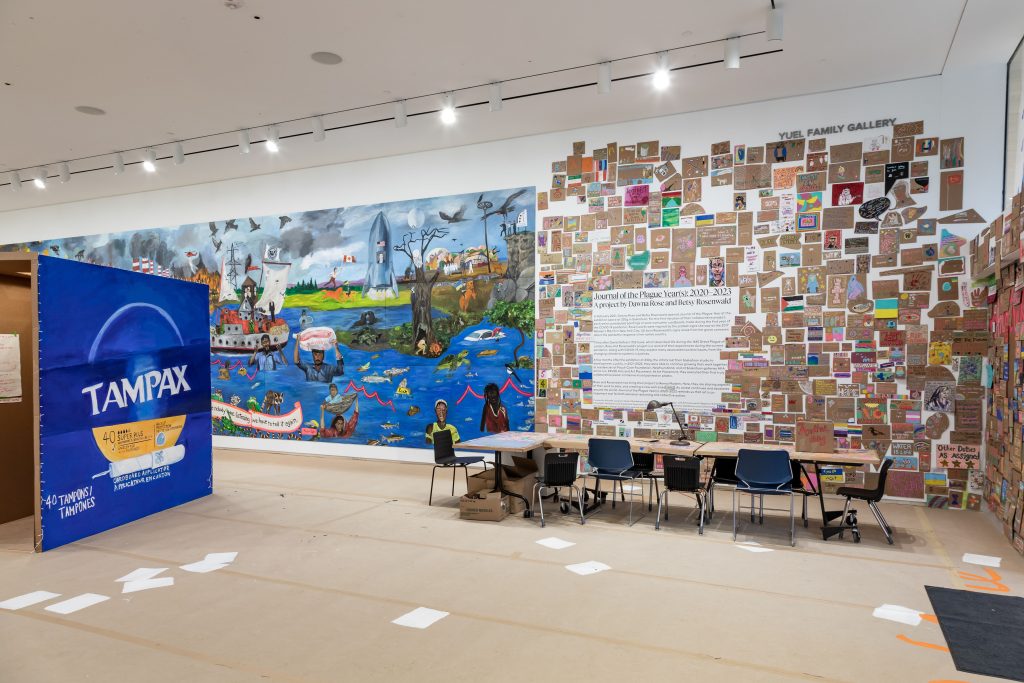
From these jumping off points, we began adding whatever came to mind. We added a Noah’s Ark-like boat in the centre, poised to rescue endangered species of birds, snakes, insects, frogs, turtles, and animals of all kinds from extinction. Slowly, it morphed into a battleship manned by armed soldiers, protecting a few powerful tyrants from the havoc they have wreaked on the world. In the background, Elon Musk is set to escape in his SpaceX rocket, while Justin Trudeau rides bareback, waving a Canadian flag. Greta Thunberg, whose warnings about climate crisis have gone largely unheeded, floats alone in a rowboat without oars.
–Betsy and Dawna

